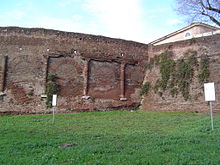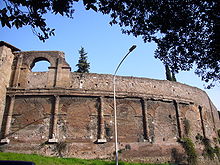Amphitheater Castrense
The amphitheater Castrense was an amphitheater in the city of Rome at the time of the Roman Empire . Besides the Colosseum , it is the only amphitheater in the city of which remains are still preserved today. However, little attention is paid to it and it is not open to the public.
Construction

The amphitheater is built entirely of fired bricks , which is unusual for the construction of theaters. Until the time of Emperor Nero , the construction of wooden amphitheatres has been handed down in Rome; later, as in the one from 70 BC, they were built. The amphitheater from Pompeii , dating from the 4th century , was made of stone to reduce the risk of fire and collapse. In the Castrense Amphitheater, even the half-columns and pilasters, including the Corinthian capitals, are made of brick; only the base of these elements consists of stone slabs on the ground floor.
The amphitheater has an elliptical floor plan. At 75.8 meters, the minor axis reaches around 85 percent of the 88 meter long main axis. The advantages of a circular building could thus be combined with the requirements of an elongated arena . This floor plan can still be seen today in the foundations of the amphitheater, which were cast from cement mixed with small stones. The brick building could be erected on these foundation walls. Like the Colosseum originally, the Castrense amphitheater consisted of three rows of arcades , the remains of which were preserved until the 16th century. On the ground floor there were round arches that rested on half-columns, the first floor consisted of arcades, closed by low balustrades and framed by pilasters. The second floor completed the building with a window wing, which was also divided by pilasters. This floor probably had a cornice made of Roman travertine from Tivoli to which the poles for raising the velarium , a sail to protect against the sun, could be attached. During excavations in the 18th century, underground installations such as those in the Colosseum were found.
In the middle of the 16th century, Pope Paul IV had the remains of the upper two floors removed because he wanted to use the wall as a defensive structure.
Time of origin

During the reign of Emperor Trajan (98–117 AD), many buildings were built as brick structures; this type of construction flourished in the 2nd century. It was therefore initially assumed that it could be the "large circular theater" (θέατρον μέγα κυκλοτερὲς πανταχόθεν) built under Emperor Trajan, which Pausanias (5, 12, 6) is one of the most important buildings of Trajan. Esther Boise Van Deman assigned the building to the emperor Septimius Severus , the founder of the Severan dynasty.
However, due to the lack of the stamps characteristic of the brick buildings of that time , a later date for the emergence of the amphitheater became more likely. Part of the gardens in the district of ad Spem Veterem at the foot of the Esquiline , where the amphitheater stands, belonged to the Varii family towards the end of the 2nd century AD . In the horti Variani , as these gardens were called, there was a suburban villa . Through Sextus Varius Marcellus , the father of the later emperor Elagabal (218–222 AD), who was originally called Varius Avitus Bassianus, the area came into imperial possession in the first half of the 3rd century. Elagabal was a great-nephew of the emperor Septimius Severus. He and his successor Alexander Severus (222–235 AD) expanded the villa into an imperial palace, the sessorium .
The fact that the amphitheater Castrense stands next to the remains of this palace and had a road connection to it makes it likely that it was built at the same time. The amphitheater with its 3500 seats could have been intended primarily for the imperial court.
The palace was later inhabited by Helena , mother of Emperor Constantine (reign 306–337 AD). One room in the palace was converted into the Santa Croce church during Helena's lifetime , the convent of which the amphitheater now uses as a garden.
designation
The naming of the amphitheater as castrense , ie “ belonging to the castra ”, becomes plausible if the translation for castra with “castle” or “courtyard” is considered. Then it becomes clear that it could actually have been an amphitheater belonging to the Imperial Court of Severus. Another interpretation connects the name with the Castra praetoria of the Praetorian Guard and claims a predominantly military use of the amphitheater. This meaning of the name seems to be less fitting, however, as the Castra praetoria were much further from the amphitheater than the imperial palace, which had a direct road connection to the amphitheater.
It has often been doubted that the remains of this amphitheater are actually the Castrense amphitheater. The name is only known from the copies of a building directory of the city of Rome, which was last edited under Emperor Constantine. The list is based on the 14 boroughs, the regions that were established in the time of Augustus . In the Discriptio XIIII Regionum Urbis Romae , the Amphitheater Castrense is mentioned in the Regio V Esquiliae , the fifth district.
Aurelian wall

During the reign of Emperor Aurelian (270–275), a second, larger ring of walls began to be built around Rome, the Aurelian Wall . It was built almost entirely from bricks. Apparently, the emperor thought the fortifications were so urgent that existing structures were included, including the Cestius pyramid , the Castra praetoria , parts of the Aqua Claudia aqueduct and the Castrense amphitheater.
Nevertheless, the Ostrogoths under their king Witichis are said to have broken through the walls of Rome in the 6th century AD at the exact location of the amphitheater. However, they did not succeed in advancing further into the city occupied by the troops of the Eastern Roman general Belisarius .
literature
- Eva Margareta Steinby : Lexicon Topographicum Urbis Romae . Vol. 1. 2. Ed. Quasar, Rome 1993, ISBN 88-7097-019-1 .
- Ernest Nash : image dictionary on the topography of ancient Rome. Volume 1: Amphitheatrum Castrense - Lacus Curtius . Published by the German Archaeological Institute. Ernst Wasmuth Verlag, Tübingen 1961
Web links
- Platner / Ashby: A topographical dictionary of ancient Rome , London 1929, Art. Amphitheatrum Castrense
- Amphitheater Castrense, Rome in the Arachne archaeological database
- Castrense amphitheater at LacusCurtius
- Building entry for Amphitheatrum Castrense in the archaeological database Arachne
- Rome, Amphitheatrum Castrense. In: Amphi-Theatrum .
Coordinates: 41 ° 53 ′ 15.5 " N , 12 ° 30 ′ 54.3" E

